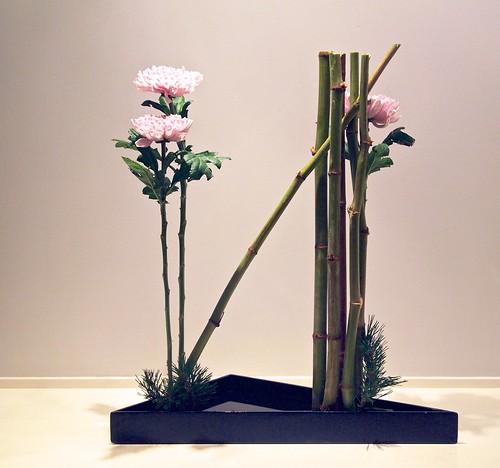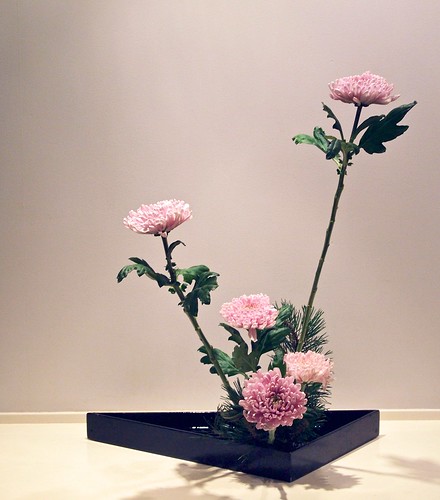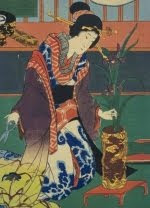Today, the ninth day of the ninth month, is the day of the the Chrysanthemum Festival, Kiku Matsuri. It's the fifth and final of a series of seasonal festivals, the Go-Sekku. The Chrysanthemum, Kiku in Japanese, is the most celebrated of all Japanese fall-flowering plants.
Chrysanthemum, Japanese Knotweed and pine.
Abstract freestyle, straight lines, kabu-wake.
In old Chinese traditions the day is also called 'Double Yang Festival'. According to Chinese tradition, nine is a yang number. The ninth day of the ninth lunar month gives a 'double ninth', and makes this a day that has too much yang energy. Because of that is said to be a potentially dangerous date. Translated to the Gregorian calendar this places the festival somewhere late October to mid November. In 2014 the date is October 2. Another explanation says that odd numbers are lucky numbers, and as nine is the highest of them a double nine gives a very auspicious day. This festival has come to be associated with chrysanthemum flowers as they are believed to protect against danger. Chrysanthemum petals are placed in sake cups. The chrysanthemum can also be used as tea, wine or even as a vegetable. Chrysanthemum are considered to have cleansing qualities and give long life.
In Japan, the festival is known as 'Choyo' and is most commonly celebrated on September 9. Japan's Royal family holds a 'viewing Chrysanthemum banquet'. However, most of the celebrations of Kiku seems to still follow the lunar calendar. Big exhibitions, Kikka-ten, of the most impressive Chrysanthemum are held in many places in October and November. The Chrysanthemum was introduced to Japan from China and the Japanese have since developed a special talent for growing and refining this flower.
The Chrysanthemum also have long traditions in the history of ikebana. It's been told that The Emperor Saga (810-823) brought the art of ikebana to perfection when he arranged yellow and white Chrysanthemums from an island in the pond at the palace Daikakuji. He put them in a flower vase, without adjusting any stems or leaves, and was so pleased with the result that he said "Hereafter, if you want to put flowers in a vase, follow this example of mine."
Big Chrysanthemum flowers are often arranged together with pine. I've made two arrangements, one traditional fan style and one contemporary abstract, that are meant to show the strength and elegance of the Kiku.
Abstract freestyle, straight lines, kabu-wake.
In old Chinese traditions the day is also called 'Double Yang Festival'. According to Chinese tradition, nine is a yang number. The ninth day of the ninth lunar month gives a 'double ninth', and makes this a day that has too much yang energy. Because of that is said to be a potentially dangerous date. Translated to the Gregorian calendar this places the festival somewhere late October to mid November. In 2014 the date is October 2. Another explanation says that odd numbers are lucky numbers, and as nine is the highest of them a double nine gives a very auspicious day. This festival has come to be associated with chrysanthemum flowers as they are believed to protect against danger. Chrysanthemum petals are placed in sake cups. The chrysanthemum can also be used as tea, wine or even as a vegetable. Chrysanthemum are considered to have cleansing qualities and give long life.
In Japan, the festival is known as 'Choyo' and is most commonly celebrated on September 9. Japan's Royal family holds a 'viewing Chrysanthemum banquet'. However, most of the celebrations of Kiku seems to still follow the lunar calendar. Big exhibitions, Kikka-ten, of the most impressive Chrysanthemum are held in many places in October and November. The Chrysanthemum was introduced to Japan from China and the Japanese have since developed a special talent for growing and refining this flower.
The Chrysanthemum also have long traditions in the history of ikebana. It's been told that The Emperor Saga (810-823) brought the art of ikebana to perfection when he arranged yellow and white Chrysanthemums from an island in the pond at the palace Daikakuji. He put them in a flower vase, without adjusting any stems or leaves, and was so pleased with the result that he said "Hereafter, if you want to put flowers in a vase, follow this example of mine."
Big Chrysanthemum flowers are often arranged together with pine. I've made two arrangements, one traditional fan style and one contemporary abstract, that are meant to show the strength and elegance of the Kiku.
Chrysanthemum and pine.
Fan style, variation no. 3.














No comments:
Post a Comment